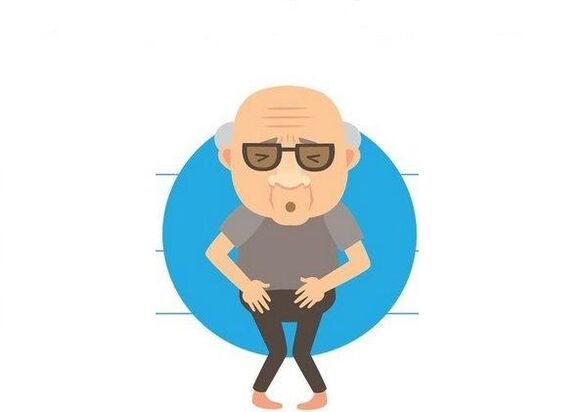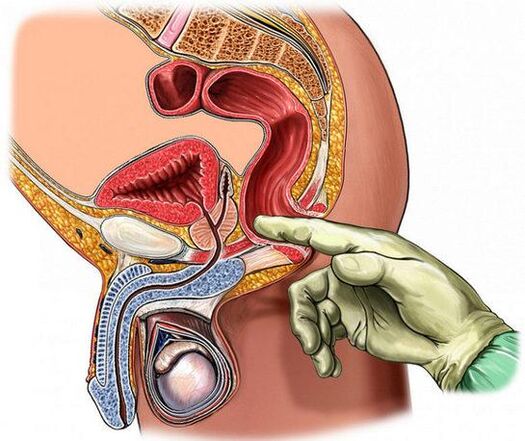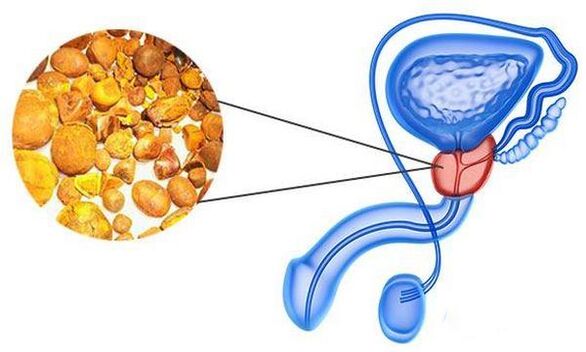The symptoms of prostatitis depend on the shape and cause of prostatitis and the presence of the accompanying disease. Symptoms usually intersect, which significantly complicates the diagnosis.

Chronic prostatitis
Chronic prostatitis develops as a complication of a separate disease or acute inflammatory form. During the remission, symptoms are weak or absent at all, and they become more pronounced as they become more apparent. Clinical images are similar to acute prostatitis.
The first symptoms of chronic inflammation form:
- Frequent urge to urinate;
- The pain of stupid lower abdomen;
- Discomfort in the prostate area (from the testicles to the anus) and sit in a sitting position for a long time. Then, I was unable to sit for more than an hour due to burning.
- Intermittent, painful urination;
- Rectal pain during bowel movements;
- The worsening of the erection and discomfort in the groin during ejaculation are possible.
The above-mentioned signs of chronic prostatitis form will not be immediately shown. Initially, this could be lubricating orgasm, premature ejaculation, and then the man must be tired while urinating, and the pain gradually joins in.
On ultrasound with chronic inflammation, an increase in the degree of reflection of fabric waves was observed, resulting in a decrease in the density of prostate tissue. In some places, it is reduced in the presence of cysts or in the exposure to calcium alkali (stone), the focus of sclerosis (from the focus of the seal of connective tissue), which is formed by the recovery process after acute inflammation). In the later stages of connective tissue and fibrosis, more and more. The size of the prostate is reduced. During the visual diagnosis, it has become difficult to distinguish it from the surrounding fibers.
Acute prostatitis
The acute form of infectious (bacterial) prostatitis is characterized by rapid development. The severity of symptoms depends on the extent of damage to the glands. Using the form of catal (inflammation only affects the duct), a person will feel only mild discomfort during stress in the groin area. In the finger examination of iron, it increases slightly and has little pain.
The forms of follicles (purulent inflammation of each leaf of the gland), parenchymal (inflammatory lesions in all tissues of the prostate) and abscess (capsules that form purulent content) are reflected by the complexity of the entire symptoms:

- Strong shooting pain in the groin, inside the hips of the penis, inside the rectum, testicles, s bones, s bones.
- Fever, general weakness. The positive development of pathogens can cause poisoning of the body by inflammatory products.
- Recovering when urinating, this feeling does not completely empty the bladder (due to stimulation of the sphincter and urethral mucosa).
- Purulent discharge from the urethra (Pus comes out of the duct of the prostate and enters the urethra).
- Feeling of perineum severity.
- A fast heartbeat attack.
- Worm urine with purulent lines. Blood may appear.
Accompanied with the parenchymal form of prostatitis, rectal pain and pulsational pain make it difficult to defecate. The small relief lies only in posture. Usually, inflammation of the prostate extends to the rectum, and mucus is extracted from the anus. Urination against parenchymal form of background may be completely stopped due to severe glandular edema.
External signs of ultrasound acute prostatitis:
- Extended venous plexus. Vascular patterns are expressed more clearly;
- expansion of glandular ducts and capsules (swelling, uneven increase, contour stab);
- Use fabric to increase the degree of reflection of the wave;
- The seed bubbles on the lateral prostate are asymmetric due to heterogeneous filling, and the pipes that remove the seeds expand.
Using a suspected tumor, an MRI or CT was prescribed.
Stagnant prostatitis
In young people and older men, prostatitis has stopped (also known as bacteria without infection). The main symptoms are similar to infectious chronic inflammation. A unique feature is the urinary discomfort due to long-term sexual desire. Intensification leads to violent expansion of intercourse, a non-core orgasm (no proper emotional coloring). Painful urination (horning) is usually observed in the morning. However, if the previous day was all orgasm, there were no cramps.
Using this type of prostatitis, the amount of white blood cells in the secret of the gland does not exceed the standard, and there is no pathogenic bacteria in the third part of the urine.
Calcified prostatitis
Calcified prostatitis has no specific symptoms. The presence of stones (calcium) in the glands does not mean the automatic development of their inflammation. The pain in the background can be exacerbated by physical fatigue. The migration of stones through pipes can sometimes stimulate the appearance of blood in the urine.
During ultrasound of the prostate, calcium is detected. Due to the increase in density, they more effectively reflect the waves emitted by the device.
Characteristics of Prostatitis in Young and Mature Ages

The symptoms of various forms of prostatitis do not depend on the age category of the man. Young people are actively living sex, so they often experience an acute form of infectious inflammation with corresponding obvious signs.
A few years after the sexual activity began, the male was diagnosed with chronic prostatitis. During this time, the structure of the prostate violates its cellular immunity due to the activity of hidden infections. Symptoms occur when pathological changes are already irreversible.
Mature men suffer mainly from urination disorders, periodic perineal silly pain and erectile dysfunction. The stagnation process in the pelvis is compared with the background of androgenic failure and loss of muscle tone, prostatitis licking at this age exacerbates prostatitis.
When to contact whom
Any of the above symptoms are the cause of contact with a urologist or androgen (diagnosis of prostatitis in clinical and family conditions). Many men avoid going to the doctor for a negative attitude toward checking the prostate through the anus or trusie’s fingers (penetrating rectal ultrasound). If the patient explicitly rejects these types of studies, the doctor will provide an abdominal ultrasound when the sensor is leaning against the lower abdomen. The bladder should be filled (only drink 350 ml of fluid one hour before the operation).
Based on the results of ultrasound, doctors determined the nature of the lesions in their tissues and the prostate tissue around the bladder. To determine the cause of inflammation, in some cases it is necessary to pass through urine, blood, prostate secrets (you need rectal massage) and sperm charts.
Which diseases have similar symptoms
Many diseases have symptoms similar to prostate titanium. First, it is cystitis (cystitis). It is characterized by the frequent desire of the toilet, applying it to the lower abdomen, pain during urination, muddy urine and sometimes blood. Maybe the temperature has risen slightly.
Among men over 45 years of age, the glands and cancer of the glands are mainly excluded. Inflammation in these pathological contexts is often a secondary sign. Symptoms of adenocarcinoma are similar to those of chronic prostatitis: periodic urinary disorders cause groin pain. Through finger studies, the prostate is painless, but dense nodes are found in its structure.
Urinating at distant nights, dull urine, incomplete air from bubbles, leakage of urethra drip and heavy in the vagina are characteristics of adenomas. Illustrated by palpation and ultrasound: the prostate contour is preserved, the consistency is elastic, the surface is smooth, and the iron is hardly painful.
Urine and pain disorders in the groin may present uninfected stones of the prostate – calcium alkali present, but there is no favorable environment around which the pathogen can be linked. In this case, discomfort in the perineum can cause physical exercise and ejaculation. With the feeling of the prostate under your fingers, you can feel the cricating (wrinkles of the stone), the body of the glands is dense, nodules, and moderately painful.
Urination disorders are characterized by the chronic stage of the disease and are also characterized by sclerosis of the bladder sphincter (obstacles that pass through the urethra in the form of prominently cutting muscles). Pathology is usually the result of long-term prostate. In men under the age of 40, few are diagnosed.
For chronic prostatitis, prolonged venous lymph nodes (internal hemorrhoids) are usually taken. They can only be found using special diagnostic tools. symptom:
- Anal pain, giving the bone and crot.
- Erection violation;
- Pain intensifies rectal and perineum during bowel movements or is found in sitting positions for a long time.
There was no change in the profile and consistency of the prostate. In her secret, there is no pathological change.

Pain in the anus and perineal areas occurs with inflammation in the rectum. One feature is the strong burning sensation on the anus during and after the bowel movement, making the penis and crot. Have the urge to urine (every 20-30 minutes), and then do urine in the urine. Prozatite usually occurs simultaneously with prostatitis. In this case, parallel treatment of the two diseases is required.
The symptoms of prostatitis are also manifested as glandular tuberculosis. In the risk area for men aged 20 to 40. In the initial stages of development, the disease is almost asymptomatic. Sometimes, mild pain in the rectum and perineum occurs. Violations of urination begin in the context of participating in part of the pathological process of the gland, conveying the channels for the urinary emission.
With tuberculosis, the prostate body forms a purulent cavity. As they break through, the content flows into the urethra and is released from the penis during the bowel movement. Bacteria that fall into the ureter can stimulate the mucous membranes and cause rapid and painful urination. Through the fibers, the pus can spread to the rectum. In this case, temperature, weakness, sweating, weight loss will increase.
in conclusion
The prostate through the nerve plexus is closely related to other pelvic organs, and its inflammation is similar to that of prostatitis. Doctors must distinguish (distinguish) prostatitis from other diseases and identify related diseases. Patients should not be surprised that for symptoms of prostatitis, the examination is directed not only to iron, but also to other organs, especially to the rectum. It is important to rule out their involvement in the formation of pain and urination disorders, otherwise the treatment will not work.























